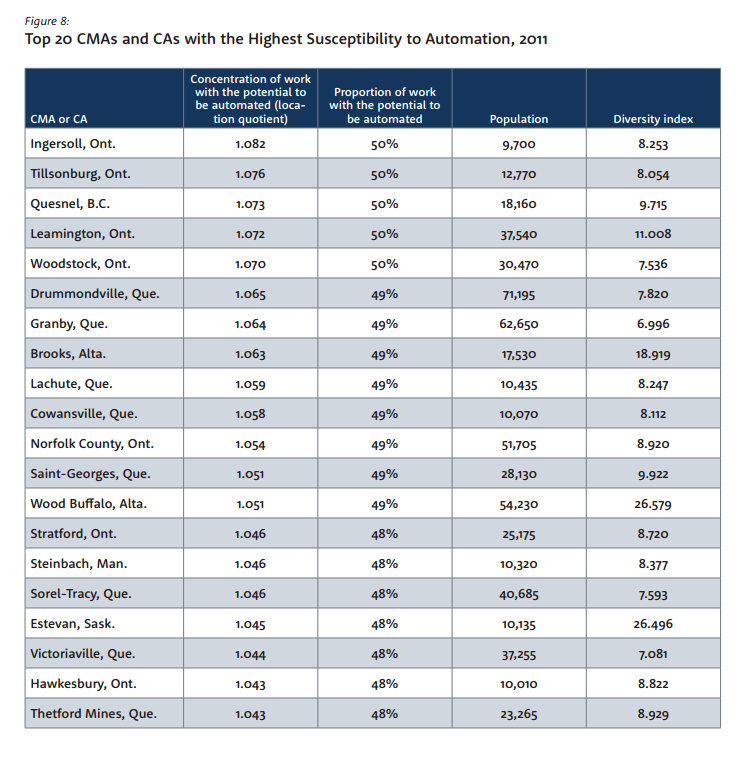Small-town Canada is where computers and robots will likely take up the largest proportion of work currently carried out by human beings, a new report finds.

Some 40 per cent of Canada’s work activities could become obsolete because of automation, but some communities are much more vulnerable than others, according to the Toronto-based Brookfield Institute for Innovation + Entrepreneurship (BII+E).
READ MORE: These are the jobs that are safe from the robot workplace invasion
Smaller centres that are highly dependent on manufacturing, mining and agriculture and forestry will likely suffer the most, researchers wrote. The Prairies, southwestern Ontario and southern Quebec have the highest concentration of these regional economies.
By contrast, towns where hospitals, universities, or the government provide most of the jobs, will feel the least impact.
Big cities lie in the middle of the pack. Here computers and robots will affect a large share of the labour force, but workers displaced by automation will have an easier time finding new jobs.
The report shows that in and around Fort McMurray, Alta., a whopping 30 per cent of employment comes from the natural resource sector and another 11 per cent from construction — two industries where many jobs involve routine tasks that robots and computers already can or will soon be able to perform. As a result, nearly half of local work could be lost to automation.
READ MORE: Will you be replaced by a robot? A look at what jobs are going to the bots
The town encapsulates what the future might hold for large swathes of Alberta, where many jobs shed during a recession triggered by low oil prices may never come back. Natural resources companies, for example, may switch to self-driving vehicles in oil sands fields and quarries, instead of re-hiring laid-off drivers.
A similar fate likely awaits Woodstock, Ont., where a quarter of the population works in manufacturing and another seven per cent in the accommodation and food industry, two sectors where more and more tasks are being automated.
WATCH: Hotel staffed by robots opens up in Japan
Although robots on assembly lines are nothing new, the authors of the report warn that the process of automation is far from over in Ontario and the rest of country. Canadian manufacturers currently employ just one robot for every 10,000 workers on average, far lower than in other nations with a heavy manufacturing imprint such as Germany.
And robots are becoming cheaper, meaning smaller Canadian companies will soon be able to afford them.
Contrast that with Fredericton, N.B., where nearly 40 per cent of workers toil in the public administration, education or the health-care sectors, where a large share of jobs involve human interaction and management skills for which machines are no substitute. Here, less than 45 per cent of the work has the potential to be automated.
READ MORE: What do Canadians think of basic income? It will reduce poverty but could raise taxes
BII+E came to these conclusions after combing through Canada’s 2011 Census and applying data from a global study of automation by consultancy McKinsey & Company.
“By better understanding the geographic distribution of this trend, we believe the country will be much better prepared to weather the risks and reap the potential benefits of automation,” Sean Mullin, executive director of BII+E said in a statement.
Below is a list of the Canadian communities most and least vulnerable to automation:





Comments